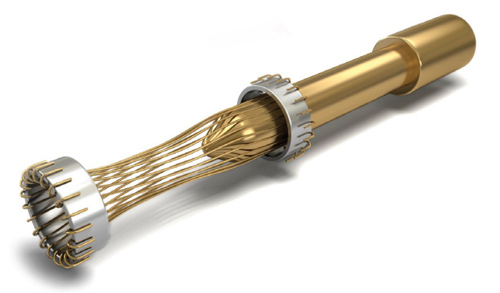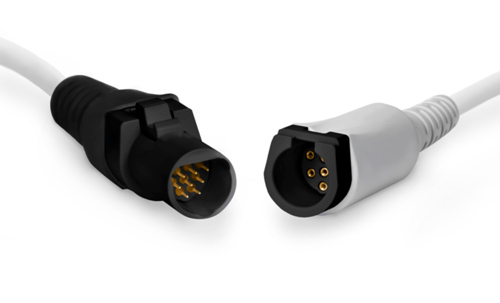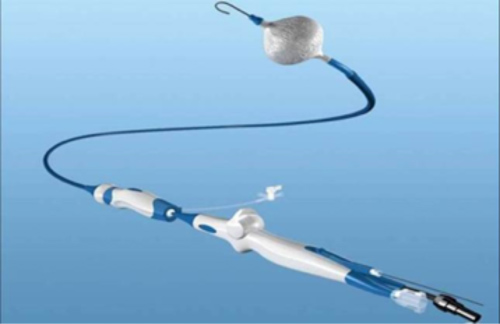As they say in Minnesota: “You Betcha!”

In the mid-1950s, a Frenchman, Francois Bonhomme, invented a new connector to address the unique needs of the rail industry. The primary concern was maintaining stable electrical contact during the shock and vibration abuse that is routinely experienced during rail travel. The contact was sold through his company, which became Hypertac France. It, along with the other Hypertac licensed companies in Europe and the US, was subsequently acquired by Smiths Group and now serves the global marketplace under the Smiths Connectors brand.
The Smiths Connectors Hypertac (hyperboloid contact) concept involves mating a round screw machine pin with a socket contact containing a hyperboloid array of gold plated wires inside a tube-shaped ferrule, rotated such that the wires spiral around the pin in lines rather than the discrete points of contact found on the vast majority of stamped or screw machine receptacle contact designs. Not only do these wires contact the pin over a long distance when fully mated, but they also wipe along the pin during engagement, effectively polishing the pin and displacing contaminants that might be present. The wires are fixed in position during assembly by screw machine components at each end of the ferrule tube. The front cap provides a lead-in for the pin. The socket can be configured for solder-to-wire, crimp, solder tail to PCB, or compliant press fit. During mating, the wires are elastically stretched, gripping the pin from all sides.

The original design was for power connectors in wiring harnesses between rail cars. The idea proliferated in the 60s, 70s, and 80s to a variety of applications in medical, aerospace, testing, industrial and military markets. The contact concept proved quite scalable. The smallest contacts mate with 0.3 mm pins on pitches as tight as 1 mm, and are rated for 1 A of continuous current. For higher power contacts, larger diameter pins and wires are used.
The effect of this combination of characteristics ensures a contact mating system with very predictable, stable mating and normal forces. Such a contact has the advantages of providing low mating forces and exceptionally high mating cycle life; >100,000 cycles. Because the wires wrap around the pin, the surface area in contact is quite generous, reducing resistance and temperature rise, and increasing current flow. Designs using Smiths Connectors contacts will typically be rated for 30-40% more current than comparable screw machine or stamped contact designs. Further, each pin mates with a minimum of five wires, providing a great deal of redundancy for the ultimately stable electrical connection.

The Jet Propulsion Laboratory of NASA recognized the merits of this design and has done extensive testing to validate that connectors with the hyperboloid contacts are well suited to the rigors of outer space. When man finally visits Mars, we will be able to check the condition of the Smiths Connectors contacts on the Curiosity rover. I am confident that they will still be working fine. These contacts are also aboard the Rosetta spacecraft launched by the European Space Agency to study comets. As the U.S. gets back into the manned launch vehicle business, Smiths Connectors will be along for the ride.
Today, these contacts are manufactured in multiple facilities around the world. One of the dominant application areas is in a variety of medical applications, especially those where one-half of the mating system sees many mating cycles and stable electrical performance is critical. Patient monitoring systems, for example, require a harness that is mated to the monitor frequently. Sensors can measure blood oxygen, heart rate, blood pressure, etc. Other systems use similar interconnects for cables for external pacemakers and defibrillators, bone healing devices, heart assist pumps and the like. Non-magnetic versions of the connectors are ideally suited to connect the RF coils which are used on the patient while inside MRI machines. The people at Smiths Connectors take great pride in the fact that their connectors are an integral part of the improvements in medical care that are saving lives every day. One application, for example, is to connect the electrophysiology catheters that are used for treating heart defects without the risk involved with open chest surgery. It is interesting to note that this connector can have around 40 contacts, serving diagnostic systems, sensors and high current for tissue ablation.
Our thanks go out to Monsieur Bonhomme for this life-saving invention. I suspect he had no idea how broadly his invention would be used. Further congratulations to the many Smiths Connectors engineers over the years that developed the manufacturing technology to produce the hyperboloid contact and creatively adapted the concept to meet the needs of so many diverse applications. In my view, the hyperboloid connector wins the award for most sensuous connector in the industry. By the way, European trains continue to use connectors with these contacts over 50 years after they were invented.

I’m glad to see HYPERTAC style connectors still in use. Having worked with many ATE systems throughout my working life (~40 years). The ONLY connectors that I’ve come across that give a near 100% reliable connection are HYPERTACs. I know of a system built in 1978 that has over one thousand connections to its associated adaptors that still runs fine!